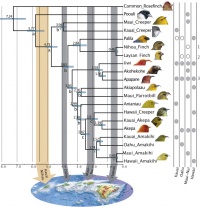Lerner et al. 2011
Lerner, H. R., Meyer, M., James, H. F., Hofreiter, M., & Fleischer, R. C. (2011). Multilocus resolution of phylogeny and timescale in the extant adaptive radiation of Hawaiian honeycreepers. Current Biology, 21(21), 1838-1844.
https://www.cell.com/current-biology/fulltext/S0960-9822(11)01078-5
Published Abstract
Highlights
- Of 28 outgroups, Eurasian rosefinches, an Old World clade, are the sister group
- Using island age calibrations, the radiation originated about 5.8 million years ago
- Most novel morphological lineages originated early on, before Maui-Nui formed
- Sequencing many synonymous and noncoding sites was key to resolving the phylogeny
Summary
Evolutionary theory has gained tremendous insight from studies of adaptive radiations. High rates of speciation, morphological divergence, and hybridization, combined with low sequence variability, however, have prevented phylogenetic reconstruction for many radiations. The Hawaiian honeycreepers are an exceptional adaptive radiation, with high phenotypic diversity and speciation that occurred within the geologically constrained setting of the Hawaiian Islands. Here we analyze a new data set of 13 nuclear loci and pyrosequencing of mitochondrial genomes that resolves the Hawaiian honeycreeper phylogeny. We show that they are a sister taxon to Eurasian rosefinches (Carpodacus) and probably came to Hawaii from Asia. We use island ages to calibrate DNA substitution rates, which vary substantially among gene regions, and calculate divergence times, showing that the radiation began roughly when the oldest of the current large Hawaiian Islands (Kauai and Niihau) formed, ∼5.7 million years ago (mya). We show that most of the lineages that gave rise to distinctive morphologies diverged after Oahu emerged (4.0–3.7 mya) but before the formation of Maui and adjacent islands (2.4–1.9 mya). Thus, the formation of Oahu, and subsequent cycles of colonization and speciation between Kauai and Oahu, played key roles in generating the morphological diversity of the extant honeycreepers.
